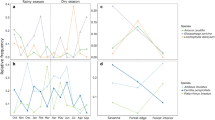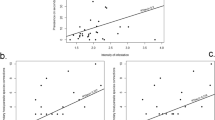Abstract
IN the dry months from January to March in Central America there is an abundance of flowering trees and shrubs1–3 and many of them are pollinated by bats. When collecting nectar, the bats visit various species of plants4–6, and in periods of peak abundance of flowers they make increasingly frequent visits. With flowering apparently synchronised3,4, there seems to be a good chance that flowers may not always receive conspecific pollen, thus reducing their seed set and fitness. The study reported here suggests that this chance is minimised because nectar and pollen are available at different times on different flower species, and because some species deposit and receive pollen at distinct regions of the bats' bodies.
This is a preview of subscription content, access via your institution
Access options
Subscribe to this journal
Receive 51 print issues and online access
$199.00 per year
only $3.90 per issue
Buy this article
- Purchase on Springer Link
- Instant access to full article PDF
Prices may be subject to local taxes which are calculated during checkout
Similar content being viewed by others
References
Janzen, D. Evolution 21, 620–637 (1967).
Croat, T. Ann. Miss. Boi. Gdn 56, 295–307 (1969).
Frankie, G., Baker, H. B. & Opler, P. J. Ecol. 62, 881–919 (1974).
Heithaus, R., Fleming, T. & Opler, P. Ecology 56, 841–859 (1975).
Alvarez, T. & Gonzalez Quintero, L. An Esc. Nac. Cienc. Biol. 18, 1–77 (1970).
Howell, D. Comp. Biochem. Physiol. 48, 263–276 (1974).
Friden, F., Eskilsson, L. & Bingefors, S. in Proceedings of the First International Symposium on Pollination 17–26 (Copenhagen, 1962).
Holm, S. Ann. Rev. Entomol. 11, 155–182 (1966).
Levin, D. & Anderson, W. Ann. Nat. 104, 455 –467 (1970).
Free, J. in Reproductive Biology and Taxonomy of Vascular Plants (ed. Hawkes, J. G.) 76–91 (Pergamon, New York, 1966).
Percival, M. New Phytol. 49, 40–63 (1950).
Goodwin, G. G. & Greenhall, A. Bull. Am. Mus. Nat. Hist. 122, 187–302 (1961).
Howell, D. & Burch, D. Rev. Biol. Trop. 21, 281–294 (1974).
Suthers, R. in Biology af Bats (ed. Wimsatt, W.) 265–310 (Academic, New York, 1970).
Mann, G. J. comp Neurol. 116, 135–144 (1961); Invest. Zool. Chilenas 9, 1–93 (1963).
Bhatnagar, K. & Kallen, F. J. Morph. 142, 71–90 (1974); Am. J. Anat. 139, 167–190 (1974).
Cooper, J. & Bhatnagar, K. J. Anat. 122, 571–601 (1976).
Darwin, C. The Effects of Cross and Self Fertilization in the Vegetable Kingdom (Murray, London, 1876).
Holdridge, L., Grenke, W. C., Hatheway, W. H., Liang, T. & Tosi, J. Jr Forest Environments in Tropical Life Zones (Pergamon, New York, 1971).
Baker, H. Science 139, 877–883 (1963).
Grant, V. Evolution 3, 82–97 (1949).
Author information
Authors and Affiliations
Rights and permissions
About this article
Cite this article
HOWELL, D. Time sharing and body partitioning in bat–plant pollination systems. Nature 270, 509–510 (1977). https://doi.org/10.1038/270509a0
Received:
Accepted:
Issue Date:
DOI: https://doi.org/10.1038/270509a0
This article is cited by
-
Effects of mixed‐species pollen load on fruits, seeds, and seedlings of two sympatric columnar cactus species
Ecological Research (2011)
-
Associations between floral specialization and species diversity: cause, effect, or correlation?
Evolutionary Ecology (2009)
-
The use of olfaction in the foraging behaviour of the golden-mantled flying fox, Pteropus pumilus, and the greater musky fruit bat, Ptenochirus jagori (Megachiroptera: Pteropodidae)
Naturwissenschaften (2003)
-
Tetrastylis ovalis: A second case of bat-pollinated passionflower (Passifloraceae)
Plant Systematics and Evolution (1992)
Comments
By submitting a comment you agree to abide by our Terms and Community Guidelines. If you find something abusive or that does not comply with our terms or guidelines please flag it as inappropriate.



